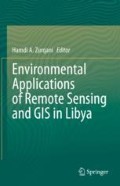Abstract
This chapter highlights the most important conclusions and recommendations from all chapters to provide perspective and guidance for students, teachers, researchers, decision-makers, etc. It includes summarized information on the latest research studies that used remote sensing (RS) and geographical information systems (GIS) techniques for environmental applications in Libya. Conclusions of different Libyan case studies related to the use of remote sensing and GIS tools have been described and several modeling approaches have been introduced. The current chapter also includes set recommendations that illustrate the relationships between remote sensing, field observations, laboratory analysis, and GIS for an integrated analysis of managing Earth’s natural resources more sustainably and addressing many of the environmental problems humans face today.
Access this chapter
Tax calculation will be finalised at checkout
Purchases are for personal use only
References
Bolick MM, Post CJ, Mikhailova EA, Zurqani HA, Grunwald AP, Saldo EA (2021) Evaluation of riparian tree cover and shading in the Chauga River watershed using LiDAR and deep learning land cover classification. Remote Sens 13(20):4172
Tarazona Y, Zabala A, Pons X, Broquetas A, Nowosad J, Zurqani HA (2021) Fusing Landsat and SAR data for mapping tropical deforestation through machine learning classification and the PVts-β non-seasonal detection approach. Can J Remote Sens 47(5):677–696
Wulder MA, Loveland TR, Roy DP, Crawford CJ, Masek JG, Woodcock CE, Allen RG, Anderson MC, Belward AS, Cohen WB et al (2019) Current status of Landsat program, science, and applications. Remote Sens Environ 225:127–147
Zurqani H, Mikhailova E, Post C, Schlautman M, Sharp J (2018a) Predicting the classes and distribution of salt-affected soils in Northwest Libya. Commun Soil Sci Plant Anal 49(6):689–700
Zurqani HA, Post CJ, Mikhailova EA, Schlautman MA, Sharp JL (2018b) Geospatial analysis of land use change in the Savannah River Basin using Google Earth Engine. Int J Appl Earth Obs Geoinf 69:175–185
Zurqani HA, Mikhailova EA, Post CJ, Schlautman MA, Elhawej AR (2019) A review of Libyan soil databases for use within an ecosystem services framework. Land 8(5):82
Zurqani HA, Post CJ, Mikhailova EA, Cope MP, Allen JS, Lytle BA (2020) Evaluating the integrity of forested riparian buffers over a large area using LiDAR data and Google Earth Engine. Sci Rep 10(1):1–16
Author Contributions
Hamdi A. Zurqani: conceptualization, methodology, supervision, software, data curation, formal analysis, validation, investigation, writing-original draft, visualization, writing—review and editing, review of analysis. The author has read and agreed to the published version of the manuscript.
Author information
Authors and Affiliations
Corresponding author
Editor information
Editors and Affiliations
Rights and permissions
Copyright information
© 2022 The Author(s), under exclusive license to Springer Nature Switzerland AG
About this chapter
Cite this chapter
Zurqani, H.A. (2022). Conclusions and Recommendations for Environmental Applications of Remote Sensing and GIS in Libya. In: Zurqani, H.A. (eds) Environmental Applications of Remote Sensing and GIS in Libya. Springer, Cham. https://doi.org/10.1007/978-3-030-97810-5_12
Download citation
DOI: https://doi.org/10.1007/978-3-030-97810-5_12
Published:
Publisher Name: Springer, Cham
Print ISBN: 978-3-030-97809-9
Online ISBN: 978-3-030-97810-5
eBook Packages: Earth and Environmental ScienceEarth and Environmental Science (R0)

